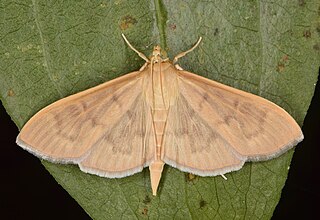
Lepidoptera is an order of insects that includes butterflies and moths. About 180,000 species of the Lepidoptera are described, in 126 families and 46 superfamilies, 10 percent of the total described species of living organisms. It is one of the most widespread and widely recognizable insect orders in the world. The Lepidoptera show many variations of the basic body structure that have evolved to gain advantages in lifestyle and distribution. Recent estimates suggest the order may have more species than earlier thought, and is among the four most species-rich orders, along with the Hymenoptera, Diptera, and Coleoptera.

Nepticulidae is a family of very small moths with a worldwide distribution. They are characterised by eyecaps over the eyes. These pigmy moths or midget moths, as they are commonly known, include the smallest of all living moths, with a wingspan that can be as little as 3 mm in the case of the European pigmy sorrel moth, but more usually 3.5–10 mm. The wings of adult moths are narrow and lanceolate, sometimes with metallic markings, and with the venation very simplified compared to most other moths.

Epicopeiidae is a family of insects in the order Lepidoptera. They are known as oriental swallowtail moths as they closely resemble some oriental swallowtail butterflies. Epicopeiidae have highly varied structure in regards to body size and wing shape. Epicopeiidaen wing patterns are involved in complicated mimicry rings.

Sasakia charonda, the Japanese emperor or great purple emperor, is a species of butterfly in the family Nymphalidae. It is native to Japan, the Korean Peninsula, China, northern Taiwan and northern Vietnam. Its wingspan averages 50 mm (2.0 in) for males, and 65 mm (2.6 in) for females. They are common in the upper canopies of forests, only coming down to feed or to find salt sources. The larvae of the species feed on hackberries, like Celtis jessoensis, Celtis japonica and Celtis sinensis.
Luma is a genus of moths of the family Crambidae. The genus was erected by Francis Walker in 1863.

Patania is a genus of moths of the family Crambidae described by Frederic Moore in 1888.
Calymniops is a monotypic moth genus of the family Erebidae erected by George Hampson in 1926. Its only species, Calymniops trapezata, was first described by Frederic Moore in 1887. It is found in India, Sri Lanka, Japan and parts of North America.

Chorodna is a genus of moths in the family Geometridae. One of its synonyms is Medasina.
Adisura atkinsoni, the field-bean pod borer, is a moth of the family Noctuidae. The species was first described by Frederic Moore in 1881. It is found in Lesotho, KwaZulu-Natal, Transvaal, Zimbabwe, Mozambique, Zambia, Malawi, Congo, Kenya, Uganda and on Madagascar. It is also present in India, China, Korea, Indonesia (Sumatra), Japan, Sri Lanka, Taiwan, Vietnam and the Himalayan region.

Lymantria mathura, the rosy gypsy moth, is a species of moth of the family Erebidae found in the Russian Far East, Nepal, Japan, the Korean Peninsula, northern India and China. The species was first described by Frederic Moore in 1866.

Blenina quinaria is a moth of the family Nolidae first described by Frederic Moore in 1882. It is found in the north-eastern Himalayas of India, western China, Vietnam, Taiwan, Peninsular Malaysia, Borneo, the Philippines and Japan.

Dichromia sagitta is a moth of the family Erebidae first described by Johan Christian Fabricius in 1775. It is found in India, Macau, Hong Kong, Japan and Taiwan.
Dolgoma cribrata is a moth of the family Erebidae first described by Otto Staudinger in 1887. It is found in eastern Asia, more specifically Russia, China, Korea and Japan.

Bocana silenusalis is a moth of the family Erebidae first described by Francis Walker in 1858. It is widespread in Asia from India to Borneo.

Patania balteata is a moth of the family Crambidae. It was described by Johan Christian Fabricius in 1798. It is found across southern Europe, Africa and Asia, including Japan, Korea, Réunion, Madagascar, Taiwan, Thailand, Turkey and Ukraine, as well as New South Wales and Queensland in Australia. There is also an old record from Hawaii.

Patania inferior is a moth of the family Crambidae. It was described by George Hampson in 1899. It is found in Siberia, Japan, Taiwan, and Indonesia.

Patania silicalis, commonly known as the herbivorous pleuroptya moth, is a species of moth in the subfamily Spilomelinae of the family Crambidae. It was described by Achille Guenée in 1854. It is found in Brazil, Venezuela, Ecuador, French Guiana, Guyana, Guatemala, Costa Rica, Panama, Mexico, Cuba, Jamaica, Puerto Rico, Hispaniola and the United States, where it has been recorded from Missouri, Michigan, Ohio and New York, south to Florida.
Patania ultimalis is a moth in the family Crambidae. It was described by Francis Walker in 1859. It is found in Sri Lanka, Myanmar, Japan, Taiwan and Australia.
Eugene Gordon Munroe was a Canadian entomologist who discovered numerous species of insects. He worked for the Insect Systematics and Biological Control Unit, Entomology Division in Ottawa, Ontario, Canada.
Avitta rufifrons is a moth of the family Noctuidae first described by Frederic Moore in 1887. It is found in the Indian subregion, Sri Lanka, New Guinea, and Queensland, Australia.













